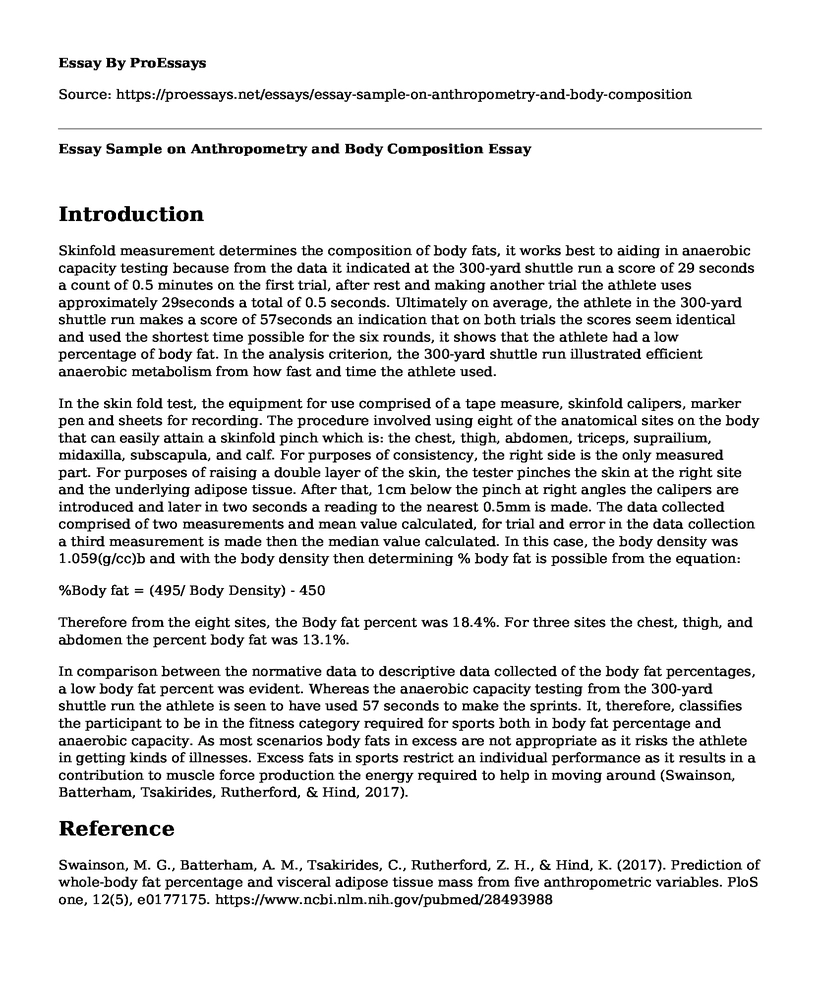Introduction
Skinfold measurement determines the composition of body fats, it works best to aiding in anaerobic capacity testing because from the data it indicated at the 300-yard shuttle run a score of 29 seconds a count of 0.5 minutes on the first trial, after rest and making another trial the athlete uses approximately 29seconds a total of 0.5 seconds. Ultimately on average, the athlete in the 300-yard shuttle run makes a score of 57seconds an indication that on both trials the scores seem identical and used the shortest time possible for the six rounds, it shows that the athlete had a low percentage of body fat. In the analysis criterion, the 300-yard shuttle run illustrated efficient anaerobic metabolism from how fast and time the athlete used.
In the skin fold test, the equipment for use comprised of a tape measure, skinfold calipers, marker pen and sheets for recording. The procedure involved using eight of the anatomical sites on the body that can easily attain a skinfold pinch which is: the chest, thigh, abdomen, triceps, suprailium, midaxilla, subscapula, and calf. For purposes of consistency, the right side is the only measured part. For purposes of raising a double layer of the skin, the tester pinches the skin at the right site and the underlying adipose tissue. After that, 1cm below the pinch at right angles the calipers are introduced and later in two seconds a reading to the nearest 0.5mm is made. The data collected comprised of two measurements and mean value calculated, for trial and error in the data collection a third measurement is made then the median value calculated. In this case, the body density was 1.059(g/cc)b and with the body density then determining % body fat is possible from the equation:
%Body fat = (495/ Body Density) - 450
Therefore from the eight sites, the Body fat percent was 18.4%. For three sites the chest, thigh, and abdomen the percent body fat was 13.1%.
In comparison between the normative data to descriptive data collected of the body fat percentages, a low body fat percent was evident. Whereas the anaerobic capacity testing from the 300-yard shuttle run the athlete is seen to have used 57 seconds to make the sprints. It, therefore, classifies the participant to be in the fitness category required for sports both in body fat percentage and anaerobic capacity. As most scenarios body fats in excess are not appropriate as it risks the athlete in getting kinds of illnesses. Excess fats in sports restrict an individual performance as it results in a contribution to muscle force production the energy required to help in moving around (Swainson, Batterham, Tsakirides, Rutherford, & Hind, 2017).
Reference
Swainson, M. G., Batterham, A. M., Tsakirides, C., Rutherford, Z. H., & Hind, K. (2017). Prediction of whole-body fat percentage and visceral adipose tissue mass from five anthropometric variables. PloS one, 12(5), e0177175. https://www.ncbi.nlm.nih.gov/pubmed/28493988
Cite this page
Essay Sample on Anthropometry and Body Composition. (2022, Dec 14). Retrieved from https://proessays.net/essays/essay-sample-on-anthropometry-and-body-composition
If you are the original author of this essay and no longer wish to have it published on the ProEssays website, please click below to request its removal:
- Poverty and Substance Abuse - Sociology Essay Sample
- Bar Code Medication Administration Essay Example
- Essay Sample on Health Benefits of Organic Foods
- Deaf Rights - Essay Sample
- Paper Example on Proteins: The Building Blocks of Life and Their Essential Functions
- Essay on Estonia Protects People With Disabilities: Challenges and Opportunities
- Paper Example on Emergency Airway Management: Challenges & Solutions







